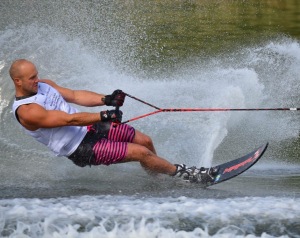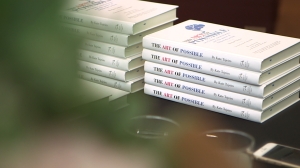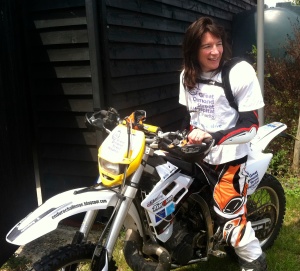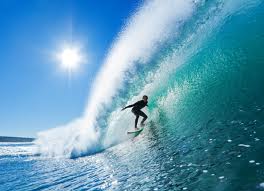Whilst my office is in a small busy town, this morning a huge bumblebee has been bumping on the window with tenacity.There is a large vase of startlingly yellow daffodils on the windowsill and they have all just come out.I think that must be what he (or she) is after!
I’ve been thinking about bees this week following a fascinating program that documented why bees ‘CAN’ fly. Their body shape, lack of aerodynamics and little wings have been baffling scientists for years because at face value- it appears an impossibility that they be able to fly at all!With the recent rapid development in sophisticated photographic technology it is now possible to ‘see’ that bees in fact flap their wings forwards and backwards, as opposed to up and down, which means that by a clever little manouevre of their wings the bee thereby creates lift on both strokes. Hence, it’s ability to fly.
And that I’m afraid is about the limit of my apiology, so why the observation?
I observed to one of my clients recently that people see, hear or sense what we put out there for them to see, hear or sense.“That’s nonsense” he confidently commented back.“People observe us but what they observe might be different to the ‘real’ us”, he said.“True”, I ventured sensing an interesting conversation in the making.“Mostly, though people see what we put out for them to see”.
Generally speaking if we are to achieve what we set out to and be successful in whatever that is- sometimes we need to ensure that our body language or non-verbal communication is in check.I.e. if we project confidence- others will identify with it, if we are unhappy and hunched people will identify with it, if we are anxious or nervous- there’s a pattern forming………
“OK – give me an example” he said.
“A client who runs a very successful PR agency was having a somewhat ‘thin’ period a few years back.
She had a pitch meeting to go to- knew that she was one of four agencies participating in the beauty parade; two were large global agencies, one a medium sized UK based agency and her small boutique consultancy.
She decided that if she had any chance at getting this contract- she was going to have to use everything she had.Best outfit, hair & nails looking good– and of course her pitch!She knew that she had the talent, credentials and ability to do the project however felt very much like the minnow against the whales. She believed that if she was self-assured, confident and demonstrated the pride she has in what she does in the meeting she’d be in with a chance.So, how does self-assured, confident and a sense of pride ‘look’ and ‘feel’ for you, I asked.Well……..she responded, shoulders back for a start, breathing deeply, not fidgeting and being myself. She is erudite, capable, funny and charming.When did you last feel like that I ventured.When I delivered a talk at an Industry Conference two years ago (two years ago! I exclaimed – that’s another story) – we talked some more about this, the talk, the audience participation, the questions – the pleasant ones and the difficult.My client now had a reference point and through discussing it had also had a mini-rehearsal. (Little piece of neuro-science- when we recall an event and think it through, good or bad, we reinforce the neural pathways in our brains which therefore make it more likely for us to repeat the behaviour again – a bit like practicing a golf swing or a tennis serve).
After the meeting, she returned to her office and her PA was the first person she saw when she walked in.“How did it go?” she said.“I got it!” she replied. “Wow- did they tell you today”. “No, I just know I got it!”
A week later, the call came to say she had got it! She did get the business, a huge global contract and it was the first of many, many more after that lean period.
When I asked her about the meeting, I could see the confidence, self-assuredness and relaxed demeanour shining through.
So, when inwardly we are thinking that something is an impossibility what are the little ‘wing manoeuvre’s that we have to employ to make a difference?
Can you think of a time when the characteristics that you want to display were shining through to complement your skills and talents.Whilst many people profess not to care what others think – said client above included – we are, like it or not, creatures who want and need to fit into a social universe. Humans are psychologically suited to interdependence.
The ability to intuit how people see us is what enables us to truly and authentically connect to others and experience the deep satisfaction that comes with those ties. With that comes the ability to understand others better be a better leader.
The bottom line: It comes down to what you think about yourself
Your ideas about what others think of you hinge on your self-concept—your own beliefs about who you are. We filter the cues that we get from other people through our own self-concept.As a baby scans his mother’s face he absorbs clues to who he is; as adults we continue to search for our reflections in others’ eyes. People rely on others’ impressions to nurture their views about themselves, says William Swann, professor of psychology at the University of Texas, Austin. His research reveals that people with negative self-concepts goad others to evaluate them harshly, especially if they suspect the person likes them—they would rather be right than be admired.
So, you get what you give?
The top line: You probably do know what people think of you
You can choose whether this is working for you or not or more importantly whether you want to do something about it or not.
There is another benefit to doing this and taking pride in what we do and demonstrating it or to put it another way: demonstrating excellence in all we do. There is something infectious and contagious about excellence and confidence. The more one produces it, the more others want to produce. You may have heard the Biblical reference, “As iron sharpens iron, so one man sharpens another.”
It is true. Often the more we observe some one we admire, the more motivated we become- not always but more often that not.
So, for the next few days try being mindful of what you are projecting with regards to how others see you.Are you confident, self-assured, calm, anxious, worried, uninterested.If you’re not sure – ask around, trusted colleagues, friends, family or your executive coach/ mentor.
How did I come across? – ask for x 3 characteristics.
Then ask yourself- was that how you wished to come across?If so, fantastic! If not, what could you do to change that.
‘Have a springy week!’ was the sign off in an email I received earlier this week which made me smile and I speculated if it was a typo.
Either way it did put a spring in my step and a client later in the day commented that I seemed bright and breezy? What came first I wondered?
Have a great spring and should you be interested in working with an executive coach/ mentor to identify your ‘wing manoeuvres’ – you know where I am!
My warmest regards,
Kate







